Trading requires an understanding of technical terms and their working mechanism. Investors should not rely on speculations but use tools to technically validate their decision to buy or sell. Upper circuit is one such factor used to make a decision. It is the maximum limit to which the price of a stock is allowed to rise in one trading session.
This article explains the concept of the upper circuit in detail. It will act as a buying or selling guide by stating some precautions and tips for the investors.
Understanding Upper Circuit
A regulatory mechanism known as the upper circuit establishes the upper limit to which the price of a stock may increase during a trading session. It is computed as a percentage of the closing price from the day before. The stock cannot move higher for the remainder of the session once it reaches this price.
This cap aims to preserve fair trading practices and safeguard individual investors. It is beneficial in situations where there is a lot of speculation or manipulation.
Use of Upper Circuit:
- In order to avoid price bubbles and excessive speculation.
- To allow investors time to evaluate news or events that are causing unexpected price changes.
- To protect consumers from purchasing goods at inflated prices.
- It helps in maintaining market stability in the case of unexpected news or panic buying.
Example:
| Stock | Previous Close | Upper Circuit Limit | Upper Circuit Price |
| ABC Ltd | Rs. 150 | 10% of 150 = Rs. 15 | Rs. 165 (150 + 15) |
Investing in Upper Circuit Stocks: Guidelines for Buying and Selling
When a stock reaches its upper circuit, investors frequently question if trading is still feasible. Let us understand some key points:
When a stock hits the upper circuit:
- Although buy orders are still possible, they won’t be fulfilled unless there are sellers who are willing.
- It is also possible to place sell orders, but the price must be at or below the upper circuit.
- Execution is completely dependent on market participants and cannot be guaranteed.
Purchasing in the Upper Circuit:
Typically, there are far more buyers than sellers. Only sellers at the upper circuit price are able to fulfil orders because the price cannot rise, and most investors wait in the hopes of making more money.
Key Points:
- The order is limited at the circuit price.
- If there are no sellers available, there is a low chance of execution.
- Price-time priority (first come, first served) is used to fill orders.
- There is a possibility of being in a queue and not being able to complete a trade.
Selling in the Upper Circuit:
A favourable exit point for current shareholders is created when buyers queue up at the upper circuit price.
Key Points:
- If an order is placed early, the likelihood of execution is higher than that of purchasing.
- Investors see it as a perfect opportunity for profit booking.
- For quicker execution, limit orders are used at the circuit price.
A table summarizing buy and sell actions:
| Action | Allowed? | Chances of Execution | Condition |
| Buying | Yes | Low | Needs available sellers |
| Selling | Yes | High | Must already hold the stock |
What Causes a Stock to Hit the Upper Circuit?
Let us now understand the reason why stocks hit an upper circuit:
1. News Announcements
- News of a merger or acquisition
- Bonus shares or a stock split
- Reducing debt or raising money
- launches of new products
2. Good Financial Outcomes
- Earnings exceeded expectations in the market.
- Increased revenue or profit margins
- Better direction or perspective from management
3. Market-wide or sector rally
- Budget announcements or favourable government policies
- Positive developments in associated sectors (such as the EV boom boosting auto stocks)
4. Speculative or Rumour-Driven Purchasing
- Influencer-driven advice or social media hype
- Unconfirmed business advancements
- Crowd behaviour in retail (herd mentality)
5. Illiquid or Low Float Stocks
- Small-cap or penny stocks with few owners
- Even small volumes can cause large price swings
- Manipulators can more easily raise prices.
Precautions for Investors
There are certain precautions that investors should exercise to avoid unnecessary loss. Here are some precautions listed below:
Precaution:
- Don’t follow the trend mindlessly: A stock is not necessarily a wise investment just because it has reached its upper circuit.
- Take the necessary precautions: Verify whether the stock’s steady growth, solid financials, and credible news are supporting the spike.
- Watch out for consecutive circuits: A stock may be manipulated or driven by an operator if it makes consecutive upper circuits without any news.
- Exercise caution when investing in illiquid stocks: If there are no buyers available during lower circuits after they reverse, you might become stuck.
- Avoid late entries: Entering after a few days of a rally raises the risk of a correction, even if the stock is fundamentally sound.
Bottomline
The conclusion can be drawn that due to certain news or better financial performance, the stock may hit the upper circuit. Even in the case of favourable government policies that positively impact the whole sector causes the price reaches the upper circuit.
Sellers may place large sell orders to book profits, but execution depends on available buyers at the upper circuit price. However, it is not compulsory for the market participants to enter the trade. It is always advised to understand these terms and then proceed with the trade.


